Submitted by AliaK on Tue, 10/09/2013 - 12:02
I've been staying in the same hotel for the past few weeks in Auckland, in different rooms each trip. I have been noticing the different patterns in the furnishings and textiles in the room. the room I'm in now has a mixture of lines and circles - none of them perfectly shaped. they have a nice feel about them, and match the nearby building's outer surfaces too. the carpet lines in the corridors flow through to match the blanket on the bed which has similar curves stitched onto the ends of the blanket.
Submitted by AliaK on Sun, 08/09/2013 - 12:00
I put the sewing machine in for a service at Chatswood Sewing Centre prior to my work trip & collected it on saturday. it's working much better! the dropped stitches problem from my previous attempts has been fixed - apparently this is caused by the timing being out, so the position of the bobbin & needle are mismatched which cause it to drop stitches intermittently.
I tried some machine embroidery and had much better results too! I haven't worked out the full control of the machine in freehand mode but I made some marks with it, and some circles. I also did another test swatch with straight stitches (in normal sewing mode) and the decorative stitches, and they're all looking much better.
the fabric is bunching a bit with the stitches. I just grabbed the first scrap of fabric from one of my bags, so I'll have to try some plain cotton too to see if that helps. also I think I need to guide the fabric more carefully and perhaps hold it taut more whilst moving it around, so it doesn't bunch up more.
zoomed in: (I need to rescan this - the scan came out blurry in parts)
Submitted by AliaK on Thu, 29/08/2013 - 11:59
this week I'm away from home, and have been sick. it's thursday and the first day my head's felt clear in ages. after a week of early night's sleep with nighttime cold'n'flu tablets I'm finally catching up on some class work.
tonight I came across these projects:
Submitted by AliaK on Sun, 25/08/2013 - 13:42
Submitted by AliaK on Sat, 24/08/2013 - 11:58
prep for assignment 2 / part 2: building a visual vocabulary
these notes are mostly to list which materials & techniques will be used in the exercises, so I know what to prepare for
project 3: colour
materials
Submitted by AliaK on Wed, 21/08/2013 - 11:56
A Creative Approach — Project 2 Developing your marks — Stage 5 — Stitches which create texture
In this exercise I had to work stitches in different directions, initially using the same type of thread, and then introducing other weight threads. I used a single colour thread (or as close as possible) for each sample. Some threads are shiny and thin whilst others are thicker, multi-threaded and matte. when you mix them together you can see the difference in texture each creates, as well as different textures caused by the different amount of light the threads reflect.
I began with satin stitch in red shades, using different stitch lengths and shiny and matte thread. The rows of satin stitch sit nicely next to each other. Some of the threads look softer and others look rougher.
My favourite sample is the thin white triangle peaks. The stitches are fairly close together, thinner at the bottom of the upside down V and there's a thicker gap at the top. I stitched different number of rows along the rows. I think this makes a nice pattern and it's something I could use in a project. I'd tried he triangle peaks in thicker orange yarn too but I don't think it's as effective — it seems to soften the edges, whereas the thinner white thread is more precise so the lines are more defined and crisper to my eyes.
Submitted by AliaK on Mon, 19/08/2013 - 11:54
A Creative Approach — Project 2 Developing your marks — Stage 4 — Preparing to create textures
In this exercise I had to look through some of my previous work and think about them in terms of textiles and creating textures. I looked at some of my sketches, but one stood out the most is the Agapanthus root from stage 3, exercise 2 — it's the ugliest topic and drawing but I think it does show a lot of texture. It's both rough and shiny, lumpy and distorted, it has hard and soft parts, and chaotic stringy parts.
Here's the drawing and original photo:
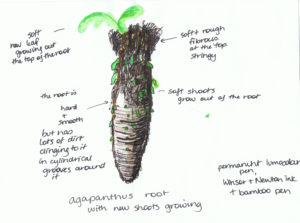
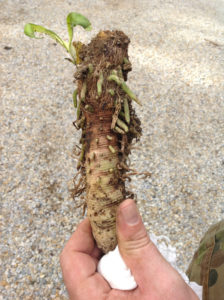
Submitted by AliaK on Sat, 17/08/2013 - 11:52
I've been looking through the craftivist collective website and some of their projects. they do many fibre / textiles / craft based activism (craftivism) projects to raise issues to people in the community. they also write about slow activism and the importance of personal reflection when making - I love this idea and it's something people can do from home without having to be too vocal (verbally) with their ideas - work on projects to highlight issues they think are important. so I purchased one of their mini protest banner kits and it arrived from the UK yesterday. tonight I embroidered a message and sewed the aida onto the fabric. it was the first time I've embroidered letters so the first couple of lines are a bit wonky (especially the "D"), and I found it easier to write in all caps so I'm probably shouting the message, but I was getting the hang of it towards the end (though I ran out of space on the last line - need to plan it out next time)
Submitted by AliaK on Mon, 12/08/2013 - 20:55
I’ve been looking through the craftivist collective website and some of their projects. they do many fibre / textiles / craft based activism (craftivism) projects to raise issues to people in the community. they also write about slow activism and the importance of personal reflection when making – I love this idea and it’s something people can do from home without having to be too vocal (verbally) with their ideas – work on projects to highlight issues they think are important. so I purchased one of their mini protest banner kits and it arrived from the UK yesterday. tonight I embroidered a message and sewed the aida onto the fabric. it was the first time I’ve embroidered letters so the first couple of lines are a bit wonky (especially the “D”), and I found it easier to write in all caps so I’m probably shouting the message, but I was getting the hang of it towards the end (though I ran out of space on the last line – need to plan it out next time)
Submitted by AliaK on Mon, 12/08/2013 - 11:51
A Creative Approach — Project 2 Developing your marks — Stage 3 — A Sample
For this exercise I chose one of my ink drawings which is mostly line based. I hand stitched in running stitch and stem stitch — in different directions and with a mixture of threads, some shiny, some matte, some thick, some sewing machine rayon so very thin. A couple of the diagonal sections turned out quite textural and layered. They have multiple threads and layers so are quite raised on the surface of the fabric. These probably would suit the following exercises. The stitches are all line based stitches though, so it shows how they can be used to create both line and texture.
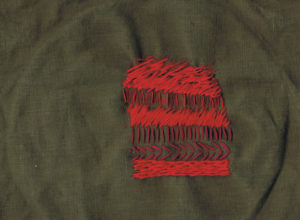
Here's the ink drawing which was used for inspiration. The top two diagonal / horizontal sections are a bit different — I was enjoying seeing the different light on the threads poke through as I stitched, so this is a bit of interpretation rather than accurate portrayal of the original picture.
Submitted by AliaK on Sat, 10/08/2013 - 11:48
I can't get the sewing machine to do freestyle machine embroidery. it seems to sew in the wrong direction - ie sew up the excess thread from the threaded needle and then the thread comes out of the needle. :( I've tried holding the threads but still no luck. I've tried with a foot on (I think it's actually a clear buttonhole foot), the foot off, tightening & loosening the screw on the bobbin holder to adjust bobbin tension and the feed dogs down. when I put the feed dogs up again it sews normally (well, as normal as it usually does - see the stitching in this first photo, with white thread plus red bobbin thread). I tried pulling the fabric tauter on the hoop and trying a thicker fabric. I haven't tried using fusible interfacing on the fabric yet though, so maybe the fabric is too thin? basically it doesn't seem to pick up the bobbin thread at all either.
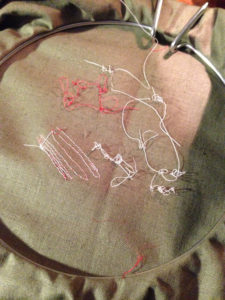
feed dogs down & feed dogs up
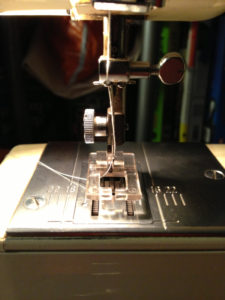
Submitted by AliaK on Wed, 07/08/2013 - 11:46
tonight I've been reading the following articles online
Submitted by AliaK on Mon, 05/08/2013 - 11:44
A Creative Approach — Project 2 Developing your marks — Stage 2 — Exploring marks and lines through stitch techniques
For this exercise, I started with machine embroidery. I dropped the feed dogs and put the fabric into the hoop, but I had to remove the footer each time I had to start sewing. The first stitch I tried, the machine just sewed on the same spot — almost like satin stitch. I found it really hard to move the fabric around. So I ended up taking the fabric out of the embroidery hoop, lifting the feed dogs again and sewing normally. This time I used red thread so it's easier to see the stitches (the first exercise was off-white on cream calico so is harder to see the stitches clearly). I didn't have any other machine threads of different weight to try the hand wound bobbin.
I made some parallel lines, moving closer together until they made a solid area (albeit small solid area!)
and I tried some circles, though they're a bit wonky. I also tried some "squaretooth" stitches as I liked the shape of these. I must have a tension issue as there's a bit of puckering of the fabric where the stitches have pulled the fabric around the stitches. I did try different stitch lengths. When I did the test swatches I found that tension=3 was the best setting, so I kept this the same for all the stitchings
Front side of the fabric:
Submitted by AliaK on Sun, 04/08/2013 - 11:41
A Creative Approach — Project 2 Developing your marks — Stage 1 — Preparation
The first stage of this exercise was to sort my fabric stash into bags. I chose to separate them by colour. There are a couple of crossovers with the greens/browns.
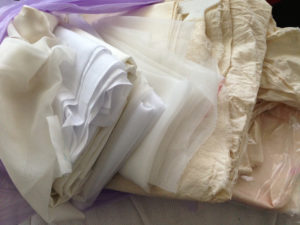
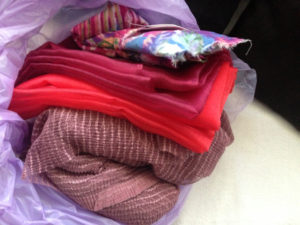
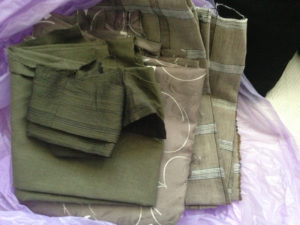
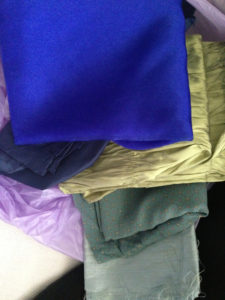
Submitted by AliaK on Fri, 02/08/2013 - 11:38
A Creative Approach — Project 1 Marking marks — Stage 4 — Working from your sketchbooks — review
Review questions
Pages